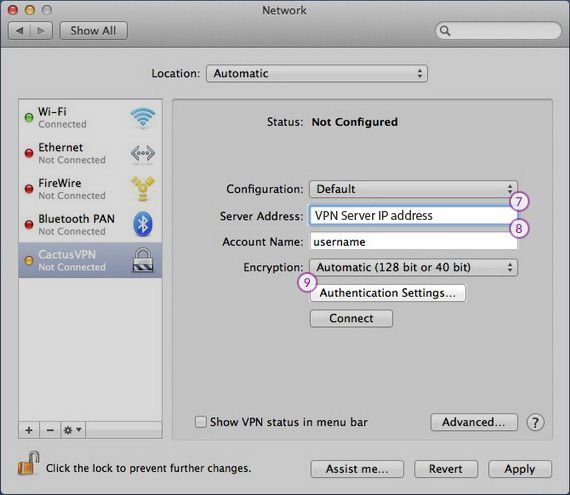Instructions For Setting Up Vpn For Mac
Use a VPN Client (The Easiest Thing) Note that some VPN providers offer their own desktop clients, which means you won’t need this setup process. All of our favorite VPNs– for advanced users, and and for basic users–offer their own desktop application for connecting to their VPNs and selecting VPN server locations.
Connect to L2TP over IPSec, PPTP, and Cisco IPSec VPNs RELATED: Use the Network control panel to connect to most. To open it, click the Apple menu, select System Preferences, and click Network or click the Wi-Fi icon on the menu bar and select Open Network Preferences. Click the plus sign button at the bottom left corner of the window and select “VPN” in the Interface box. Choose the type of VPN server you need to connect to in the “VPN Type” box and enter a name that will help you identify it.  Like other operating systems, Mac OS X doesn’t include built-in support for OpenVPN networks.
Like other operating systems, Mac OS X doesn’t include built-in support for OpenVPN networks.
Setting up your PPTP VPN under Mac OS X 10.5 (Leopard) Setting up PublicVPN access under Mac OS X 10.5 is simple. The following instructions go step–by–step through the creation process. How To Set Up a VPN On a Mac In Mac OS X, OS X Lion, Tips & Tricks by Michael Allen May 11, 2014 12 Comments Setting up a Virtual Private Networking connection on a Mac is easy and straight forward.
Scroll down for instructions for connecting to OpenVPN networks. Enter the VPN server’s address, your username, and other settings. The “Authentication Settings” button allows you to provide the authentication you’ll need to connect — anything from a password or certificate file to RSA SecurID, Kerberos, or CryptoCard authentication. The “Advanced” button allows you to configure the VPN connection in other ways. For example, the default settings automatically disconnect from the VPN when you log out or switch users. You could uncheck these boxes to prevent the Mac from automatically disconnecting. Click Apply to save your settings.
Before you do, you can enable the “Show VPN status in menu bar” option to get a menu bar icon for managing your VPN connection. Use this menu to connect to your VPN and disconnect from it as necessary. Automatically Reconnect to a VPN When The Connection Drops RELATED: By default, your Mac won’t automatically reconnect to the VPN if the connection dies.
Canon universal print driver. The uniFLOW Universal Driver can help fix the often, too common 'incompatible driver' problem. The uniFLOW Universal Driver works by ensuring that the printer specific codes are only added to the print job once the final printer type is known, resulting in a correct printout every time. UniFLOW Universal Driver on an Apple OSX This chapter describes how to set up the uniFLOW Universal Driver on an Apple OSX showing all Universal Driver options with a pop-up window. The uniFLOW Universal Driver for Mac is different to the Windows version.

To save yourself some time and hassle, use the application. It’s available for $1 on the Mac App Store. This is a simple application that basically replaces the built-in VPN on Mac OS X. If the VPN connection drops, it will automatically reconnect. This applicaiton uses the built-in VPN support in Mac OS X, so it’ll only work with connections you can configure in the Network Settings panel. If you use a third-party VPN client — for example, to connect to an OpenVPN VPN — it won’t help you. But third-party VPN clients may have this feature integrated.
If you want to save a dollar or just prefer DIY solutions, you could. Connect to OpenVPN Networks You’ll need a third-party application for connecting to OpenVPN VPNs.
The official OpenVPN website recommends the open-source application for this. Install Tunnelblick, launch it, and it will ask for the configuration files provided by your OpenVPN server. These often have the.ovpn file extension and are required for connecting from any OpenVPN client. Your OpenVPN server provider should provide them to you. Tunnelblick provides its own menu bar icon for managing your OpenVPN connections.
Select “VPN Details” and you’ll see Tunnelblick’s connection window, where you can configure how it works. For example, you can have Tunnelblick automatically connect to OpenVPN networks when this application launches. Logitech v ua1 p35u3 drivers for mac. It can automatically keep you connected to the VPN network, so you won’t need a tool like VPN AutoConnect. If you need to connect to another type of VPN network, you’ll need a different third-party VPN client with support for that type of network. Image Credit.
These instructions may seem arcane and complex but they’re really easy if you just follow along step by step. Donald Burr of Otaku No Podcast (otakunopodcast.com) created all of these instructions in text form, Allison just created the ScreenSteps tutorial! I’ll be focusing on using a Mac on your home network using an Airport Extreme Router (of course any router will work but the screenshots will be for the Airport). If you have a router capable of installing the Tomato Router Firmware, you should look at Donald’s full instructions because you may not need to use a Mac at all for this, your router can do it all. See Donald’s notes for other options. Read Donald’s instructions ===>. If you’d rather download this manual for easy off line reference, click.